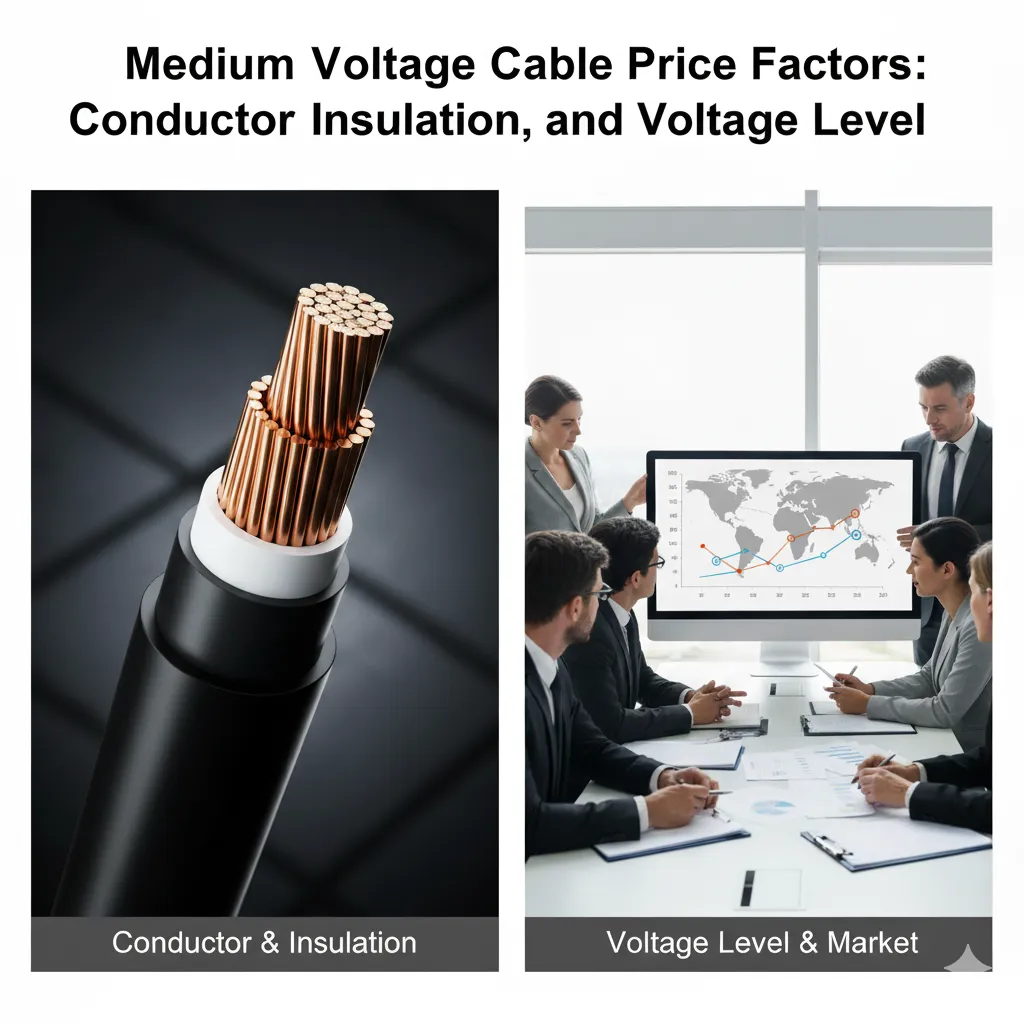Medium Voltage Cable Price Factors: Conductor, Insulation, and Voltage Level
The price of medium voltage (MV) power cables, rated from 6 kV to 35 kV per IEC 60038, is influenced by factors such as conductor material (copper or aluminum), insulation type (e.g., PVC or XLPE), and voltage level (e.g., 6/10 kV or 18/30 kV). These elements affect material costs, manufacturing complexity, and performance requirements.

Table of Contents
1. Overview of Medium Voltage Cable Pricing
MV cable prices range from $5–50/m depending on specifications, with conductor material contributing 40–60% of costs, insulation 20–30%, and voltage level influencing complexity. Factors like market fluctuations (e.g., copper prices ~$8,000/ton in 2025) and customization (e.g., armoring) also play roles. Jianyun Cable provides competitive pricing for TUV-certified MV cables, ensuring value for industrial projects.
2. Conductor Material: Copper vs. Aluminum
The conductor material significantly affects MV cable pricing due to material costs and performance:
- Copper Conductors:
- Price Impact: Higher cost (~$8,000/ton vs. $2,500/ton for aluminum), increasing cable price by 50–100% (e.g., $15–30/m for 11 kV, 50 mm²).
- Pros: Superior conductivity (<0.017 Ω/km for 50 mm²), allowing smaller sizes and lower voltage drop (<1.5%).
- Cons: Heavier and more expensive.
- Example: Jianyun Cable’s 11 kV copper XLPE-insulated cable, priced at a premium for high-performance applications.
- Aluminum Conductors:
- Price Impact: Lower cost, reducing overall price by 30–50% (e.g., $10–20/m for equivalent capacity).
- Pros: Lighter weight (2.70 g/cm³ vs. 8.96 g/cm³ for copper), easier installation.
- Cons: Higher resistance (<0.028 Ω/km for 50 mm²), requiring larger cross-sections (e.g., 70 mm² for same current).
- Example: Jianyun Cable’s 11 kV aluminum XLPE-insulated cable, cost-effective for long-distance utility lines.
| Material | Price Impact | Pros | Cons |
|---|---|---|---|
| Copper | Higher ($8,000/ton) | High conductivity, smaller sizes | Expensive, heavier |
| Aluminum | Lower ($2,500/ton) | Cost-effective, lightweight | Higher resistance, larger sizes |
3. Insulation Type: PVC vs. XLPE
Insulation affects MV cable pricing through material complexity and performance:
- PVC Insulation:
- Price Impact: Lower cost, reducing overall price by 20–30% (e.g., $10–25/m for 11 kV, 50 mm²).
- Pros: Flexible, cost-effective; 70°C max temperature.
- Cons: Lower dielectric strength (~15–20 kV/mm), limited thermal resistance.
- Example: Jianyun Cable’s 6 kV PVC-insulated cable for indoor industrial use.
- XLPE Insulation:
- Price Impact: Higher cost due to cross-linking process, increasing price by 30–50% (e.g., $15–35/m).
- Pros: Superior thermal resistance (90°C), high dielectric strength (≥20 kV/mm), low partial discharge (<10 pC).
- Cons: More expensive, less flexible.
- Example: Jianyun Cable’s 33 kV XLPE-insulated cable for renewable energy projects.
| Insulation | Price Impact | Pros | Cons |
|---|---|---|---|
| PVC | Lower (20–30% savings) | Flexible, cost-effective | Lower thermal resistance (70°C) |
| XLPE | Higher (30–50% premium) | High thermal resistance (90°C), durability | More expensive, less flexible |
4. Voltage Level: Impact on Pricing
Higher voltage levels require thicker insulation and more complex construction, increasing costs:
- Lower Voltage (6/10 kV):
- Price Impact: Lower, as insulation thickness is reduced (e.g., 2.5 mm), costing $10–20/m for 50 mm².
- Pros: Simpler design, easier installation.
- Cons: Limited power transmission distance.
- Example: Jianyun Cable’s 6/10 kV XLPE-insulated cable for short industrial runs.
- Higher Voltage (18/30 kV):
- Price Impact: Higher, due to thicker insulation (e.g., 8 mm) and enhanced shielding, costing $30–50/m.
- Pros: Longer transmission distances, higher efficiency.
- Cons: Increased complexity and cost.
- Example: Jianyun Cable’s 18/30 kV XLPE-insulated cable for utility grids.
| Voltage Level | Price Impact | Pros | Cons |
|---|---|---|---|
| 6/10 kV | Lower ($10–20/m) | Simpler, easier installation | Limited distance |
| 18/30 kV | Higher ($30–50/m) | Longer distances, efficiency | Complex, expensive |
5. Other Influencing Factors
Beyond conductor, insulation, and voltage, additional factors affect pricing:
- Armoring: SWA or steel tape adds 20–40% to costs for mechanical protection.
- Sheathing: LSZH or PUR increases price by 15–30% for fire safety or chemical resistance.
- Conductor Size: Larger sizes (e.g., 400 mm²) raise costs due to material volume.
- Market Fluctuations: Copper prices (~$8,000/ton) or supply chain issues can increase costs by 10–20%.
- Certifications: TUV or UL adds 5–10% but ensures compliance.
- Example: Jianyun Cable’s 11 kV XLPE-insulated, SWA-armored cable is priced competitively, balancing quality and cost.
6. Practical Considerations for Buyers
When evaluating MV cable prices, consider:
- Project Needs: Balance cost with performance (e.g., copper/XLPE for high-efficiency, aluminum/PVC for budget projects).
- Supplier Reliability: Choose manufacturers like Jianyun Cable with transparent pricing and TUV certifications.
- Cost Optimization: Use aluminum for long-distance runs; request bulk discounts.
- Environmental Factors: Factor in derating for high temperatures, increasing required size and cost.
- Long-Term Value: XLPE’s durability reduces maintenance costs despite higher upfront price.
7. Conclusion
Medium voltage cable prices are primarily influenced by conductor material (copper higher than aluminum), insulation type (XLPE premium over PVC), and voltage level (higher voltages increase complexity and cost). Additional factors like armoring, sheathing, and certifications add to pricing, with MV cables ranging from $10–50/m. Henan Province Jianyun Cable Co., Ltd. offers competitively priced, TUV-certified MV cables, balancing cost and quality for global projects. By evaluating these factors and partnering with reliable suppliers, buyers can achieve cost-effective, high-performance solutions for industrial, utility, and infrastructure applications lasting 25–30 years.
Source: JianYunCable.
Comments
Post a Comment